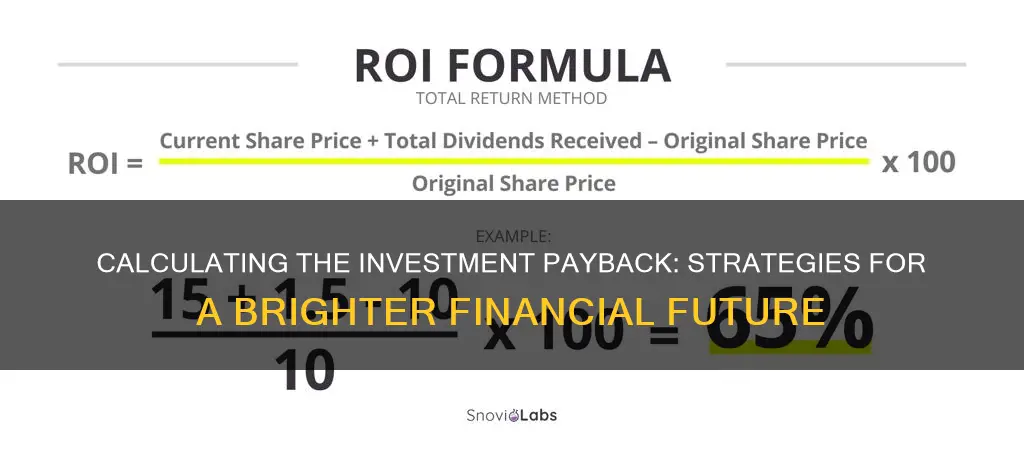
When making an investment, it's natural to wonder when it will pay for itself. This is known as the payback period. The payback period is the amount of time it takes to recover the cost of an investment. In other words, How long until this investment pays for itself?
Calculating the payback period is simple: divide the cost of the investment by the average annual cash flow. For example, if you invest $15,000 in solar panels to save $1,500 a year on your electric bill, it will take 10 years to pay off that investment.
There are many types of investments, from stocks and bonds to real estate and energy-efficient windows. Each investment comes with some degree of risk, and it's important to evaluate your comfort with risk before investing. It's also crucial to do your research and consider all factors before committing to an investment, including the payback period, to determine whether it's a worthwhile opportunity.
| Characteristics | Values |
|---|---|
| Term | Payback, ROI, Self-amortization |
| Calculation | Cost of Investment ÷ Average Annual Cashflow = Payback Period |
| Considerations | Risk tolerance, investment type, time willing to wait |
| Positive cash flow | Income > expenditures |
| Negative cash flow | Expenditures > income |
What You'll Learn

Positive cash flow
- Cover day-to-day expenses: A healthy cash flow ensures that a company can meet its financial obligations, such as paying employees and suppliers, as well as covering operational costs.
- Reinvest in the business: With positive cash flow, a company can purchase new equipment, expand its operations, and invest in research and development, fuelling future growth.
- Pay dividends: A company with positive cash flow can return profits to its shareholders in the form of dividend payments.
- Attract outside investment: Positive cash flow is an attractive signal to potential investors, who view it as an indicator of financial stability and growth potential.
- Build financial flexibility: Companies with strong cash flow are better equipped to weather economic downturns and avoid the costs associated with financial distress.
To calculate a company's cash flow, use the following formula:
> Cash on hand - expenses = cash flow
For example, if a company brings in $20,000 in a month and spends $15,000, it has a positive cash flow of $5,000.
It's important to note that positive cash flow is distinct from profit. Profit measures a company's financial success by calculating the amount of money left after paying off all its obligations. Cash flow, on the other hand, indicates the net flow of cash into and out of a business, providing a snapshot of its liquidity and financial flexibility.
Both positive cash flow and profit are critical metrics for investors and business owners to understand when evaluating the financial health and potential of a company.
Human Capital: The Investment in People
You may want to see also

Pay off high-interest credit card debt
The term "payback" is used to describe the process of an investment paying for itself over time. This payback period is calculated by dividing the upfront cost of the investment by the average annual cash flow.
If you are looking to pay off high-interest credit card debt, there are several strategies you can employ:
Pause Spending on the Card:
Stop using the credit card and switch to a debit card or cash instead. This prevents your balance from growing, except for interest charges. Using cash or debit cards can also make you more mindful of your spending and encourage you to second-guess big purchases.
Credit Card Balance Transfer:
Transfer your credit card debt from a high-interest card to one that offers a promotional 0% APR (annual percentage rate) period, which is typically 12-21 months. This allows you to pay down the debt without incurring more interest, as long as you pay it off within the promotional period. However, there may be a balance transfer fee, usually 3-5% of the transferred balance, and you will need a good or excellent credit score to qualify.
Pay More Than the Minimum:
Paying only the minimum amount will keep you in debt for longer. By paying more than the minimum, you reduce your principal balance, which results in paying less interest overall. Use a calculator to see how much faster you could pay off the debt by sending an extra $25, $50, or more each month.
Lower Your Expenses:
Look for ways to save money by reducing your monthly expenses. For example, you could ask your cellphone provider about cheaper plans or limit your spending on food by batch cooking more meals at home. Any money saved from these changes can be directed towards paying off your credit card debt.
Increase Your Income:
You can also add to your income and put that extra money towards paying off the debt. This could include asking for a raise, selling items you don't use, completing a professional certification, or freelancing in your spare time.
Cancel or Pause Subscriptions:
Audit your subscriptions and cancel or pause any that you don't truly need or enjoy. Be sure to cancel any subscriptions that automatically renew after a free trial, and keep an eye out for price increases.
Ask for Lower Interest Rates:
If you have a history of on-time payments and have been a loyal customer, you can contact your credit card issuer and request a lower interest rate. If they refuse, ask for a temporary rate reduction instead.
Focus on High-Interest Cards First:
If you have multiple credit cards with balances, focus on paying off the card with the highest interest rate first. This will prevent the balance from growing too large due to interest charges.
The Snowball Method:
Alternatively, you could try the snowball method, where you pay off the card with the smallest balance first. This provides a sense of accomplishment and motivates you to continue with your payoff plan. Once the smallest balance is repaid, you use that money to help pay down the next smallest balance.
Make Multiple Payments Each Month:
Making more than one payment per month can help reduce the interest you pay. Additionally, it can strengthen your credit score by reducing your credit utilization rate, which is the second most important factor in your credit score after payment history.
Remember, it's essential to develop a plan that works for your financial situation and stick to it. You can also seek help from a certified credit counselor at a nonprofit credit counseling agency to assess your debt and provide guidance.
Dividend-Paying ETFs: Smart Investment or Missed Opportunity?
You may want to see also

Calculate payback period
The payback period is the amount of time it takes to recover the initial cost of an investment. It is usually measured in years and is an important calculation used in capital budgeting to help evaluate capital investments.
How to Calculate the Payback Period
The payback period can be calculated by dividing the initial investment by the annual cash flow. This can be done using the following formula:
Payback Period = Initial Investment / Annual Cash Flow
For example, if a company invests $200,000 in new manufacturing equipment that results in a positive cash flow of $50,000 per year, the payback period would be calculated as follows:
Payback Period = $200,000 / $50,000 = 4 years
Advantages of the Payback Period
The payback period is a quick and easy way to assess investment opportunities and risk. It is simple to understand and calculate and can be used to compare different investment options. It also helps in assessing the risk of different investments.
Disadvantages of the Payback Period
One of the main disadvantages of the payback period is that it does not consider the time value of money. It also does not assess the risk involved with each project and does not take into account the earnings that the investment will bring in after the payback period. Additionally, it does not take into account other ways that an investment might bring value, such as partnerships or brand awareness.
Alternative Methods
Other methods that can be used to assess investment risk include the net present value (NPV) and internal rate of return (IRR), which take into account the time value of money. Another alternative is the discounted payback period (DPP) method, which adds the time value of money to the equation.
Maximizing Mineral Rights Investments: A Guide
You may want to see also

Evaluate risk comfort
Evaluating your risk comfort level is a critical step in the investment process. It involves assessing your ability to tolerate uncertainty and potential financial loss. Here are some key factors to consider when evaluating your risk comfort:
Investment Goals
Understanding your investment goals is essential in determining your risk comfort. Are you investing for the long term, such as retirement, or do you have short-term goals, such as saving for a down payment on a house? Different goals will require different levels of risk. For instance, long-term goals may allow for more aggressive investments, while short-term goals may necessitate a more conservative approach.
Time Horizon
Your time horizon, or the length of time you plan to keep your investments, is another crucial factor. Generally, a longer time horizon permits a higher-risk tolerance as there is more opportunity for recovery from potential losses. Conversely, a shorter time horizon may require a lower-risk profile to safeguard your capital.
Risk Capacity
Risk capacity refers to your ability to absorb potential losses without compromising your financial well-being. Factors such as income stability, savings, and financial obligations contribute to your risk capacity. A stable income, healthy emergency fund, and minimal debt may indicate a higher risk capacity, allowing for more aggressive strategies.
Emotional Response
Emotions play a significant role in investing. Some individuals may experience anxiety or stress during market volatility, while others may view it as an opportunity. Assessing your emotional response will help determine your comfort level. If market fluctuations cause you constant worry, you may prefer a more conservative approach.
Diversification
Diversifying your investment portfolio can help mitigate risk. By spreading your investments across different asset classes, such as stocks, bonds, and real estate, you can reduce the impact of any single investment on your overall portfolio. Diversification allows you to manage risk while potentially benefiting from the performance of different assets.
Historical Market Performance
Understanding the historical performance of financial markets can provide insights into the level of volatility you can expect. Reviewing historical data can help you gauge your tolerance for market ups and downs and determine your comfort level with risk.
Risk Management Strategies
Implementing risk management strategies, such as stop-loss orders or trailing stops, can enhance your comfort level with volatility. These strategies automatically trigger the sale of an investment if it reaches a predetermined price, limiting potential losses.
Professional Guidance
Assessing your risk comfort level can be complex, and seeking professional guidance from financial advisors can be valuable. They can assist in evaluating your risk tolerance, providing recommendations, and ensuring your investment strategy aligns with your unique circumstances.
It is important to remember that everyone has a unique risk comfort level, and it is not a static concept. As your financial situation evolves and your goals change, regularly reassess your risk tolerance to ensure your investment strategy remains aligned with your comfort level.
Invest in These 3 Things Now
You may want to see also

Diversify investments
Diversification is a common investment strategy that involves spreading your investments across a range of assets to reduce risk and volatility. Diversification is about finding the right balance between risk and reward. It's important to diversify your portfolio because it helps to mitigate the impact of market volatility and can reduce the severity of losses.
- Spread the Wealth: Don't put all your eggs in one basket. Invest in a variety of companies and sectors, including commodities, exchange-traded funds (ETFs), and real estate investment trusts (REITs). Think globally, rather than just locally, to spread your risk and increase your potential for reward.
- Consider Index or Bond Funds: Index funds and fixed-income funds are a great way to diversify your portfolio over the long term. These funds track broad market indexes and reflect the value of the bond market. They often have low fees, which means more money in your pocket.
- Keep Building Your Portfolio: Regularly add to your investments. A strategy called dollar-cost averaging can help smooth out market volatility by investing the same amount of money over time, buying more shares when prices are low and fewer when prices are high.
- Know When to Get Out: Stay informed about your investments and overall market conditions. This will help you identify when it's time to cut your losses and move on to the next investment.
- Keep an Eye on Commissions: Understand the fees you are paying and what you are getting in return. Be aware of monthly fees, transactional fees, and trading commissions, as these can eat into your profits.
It's important to note that diversification may look different for each investor, depending on factors such as time horizon and risk tolerance. While diversification can reduce overall risk, it cannot eliminate it completely. Market risk, or systematic risk, is inherent in any asset, while asset-specific risks, or unsystematic risk, are unique to individual investments or companies.
By diversifying your investments, you can boost your investment returns while reducing risk and exposure to any one type of asset.
Retirement Investments: Safe Options for the Elderly
You may want to see also
Frequently asked questions
The payback period is the amount of time it takes to recover the cost of an investment. The formula for calculating the payback period is: Cost of Investment ÷ Average Annual Cashflow = Payback Period.
It is important to accurately determine the income and expenses associated with your investment to estimate the payback period. Some factors to consider include potential rental income, cost of repairs/renovations/maintenance, property management fees, insurance, property tax rates, and utilities/council rates.
All investments carry some degree of risk. It is possible to lose some or all of your money when investing in securities such as stocks, bonds, or mutual funds. The potential for greater investment returns increases with the level of risk taken.







